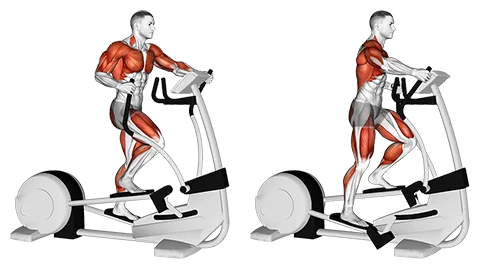Introduction
The Elliptical Cross Trainer is a cardio machine designed to simulate stair climbing, walking, or running without putting excessive pressure on your joints. Its primary benefits include improving cardiovascular health, increasing stamina, and burning calories efficiently. It's particularly effective for those seeking low-impact workouts that help achieve weight loss and toning goals.
Muscles Worked
- Primary: Quadriceps, Hamstrings, Gluteus Maximus, Calves, Cardiovascular Muscles (Heart and Lungs)
- Secondary: Abdominal Muscles, Erector Spinae, Soleus, Gastrocnemius, Tibialis Anterior, Peroneal Muscles, Serratus Anterior, Deltoids, Pectorals
How to Do It (Step-by-Step)
- Stand on the pedals of the elliptical cross trainer with a firm grip on the handles. Adjust the resistance and incline to a comfortable level if available.
- Begin by pushing down with your heels and pulling up with your toes in a smooth, circular motion, moving both arms simultaneously.
- Ensure that your posture remains upright, shoulders relaxed, back straight, and core engaged. Keep your feet flat on the pedals throughout the movement. Maintain an even pace, focusing on using both legs equally and avoiding jerky movements.
Tip: Pay attention to your breathing pattern, aiming for a rhythm that matches your stride. This will help you maintain control over your workout intensity while minimizing fatigue and maximizing efficiency.
Rep & Rest Guidelines
- Strength: 4–6 reps, 2–3 min rest
- Hypertrophy: 8–12 reps, 60–90 sec rest
- Endurance: 12–20 reps, 30–60 sec rest
Consider using Auto Progression to adapt your workouts as you progress.
Set a reliable Rest Timer to ensure optimal recovery and focus during your sessions.
Form Tips
- Maintain an upright posture with your shoulders rolled back and slightly down, keeping your chest open.
- Keep your elbows at a 90-degree angle and close to your body, moving them back and forth rather than sideways.
- Engage your core muscles for stability throughout the workout, focusing on a natural stride rather than overextending or bouncing excessively.
When to Use It
- Low Impact Cardio Recovery: Ideal for individuals returning from injury or those with joint pain, the elliptical cross trainer offers a low-impact alternative to running or jumping workouts.
- Weight Loss and Toning: A steady-state workout on an elliptical trainer can help burn calories efficiently while toning lower body muscles due to the resistance provided by its moving arms and pedals.
- Interval Training: For those seeking a high-intensity workout, short bursts of speed followed by rest periods on the elliptical cross trainer can improve cardiovascular health and boost metabolism. Workout History - Keep track of your workouts and progress with Volym's comprehensive workout history feature.
An elliptical machine simulates walking, running, or climbing stairs without the impact on joints. It uses a system of pedals and levers that move in elliptical patterns.
It provides a low-impact cardio workout, improves leg strength, offers varied resistance levels, and engages multiple muscle groups simultaneously.
Using an elliptical daily can help maintain fitness levels, but to avoid boredom and potential overuse injuries, vary your workout routine or include other forms of exercise.
Aim for 30-60 minutes per session, depending on your fitness level and goals. Shorten sessions for beginners or those recovering from injury, and increase duration over time.
Yes, using resistance can help build muscle strength, enhance calorie burn, and provide a more effective workout overall. Adjust the resistance level according to your fitness level and goals.

